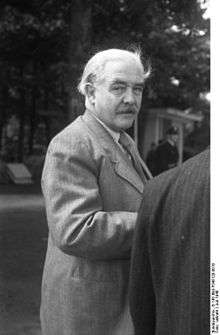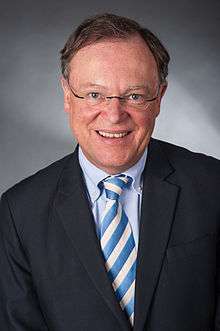Prime Minister of Lower Saxony
| Prime Minister of Lower Saxony
Ministerpräsident des Landes Niedersachsen | |
|---|---|
|
Coat of arms of Lower Saxony | |
| Residence | Hanover |
| Appointer | Legislative Assembly of Lower Saxony |
| Term length | Pending resignation or the election of a successor |
| Inaugural holder | Hinrich Wilhelm Kopf |
| Formation | 1 November 1946 |
| Salary | regulated by legislation (€13521, as of 2011)[1] |
| Website | http://www.state-chancellery.niedersachsen.de |
The Prime Minister of Lower Saxony[2][3] (German: Ministerpräsident des Landes Niedersachsen), also referred to as Premier or Minister President, is the head of government of the German state of Lower Saxony. The position was created in 1946, when the states of Brunswick, Oldenburg, Schaumburg-Lippe and the State of Hanover were merged to form the state of Lower Saxony. The current Prime Minister is Stephan Weil, heading a coalition government between the Social Democrats and the Greens. Weil succeeded David McAllister following the 2013 state election.
The office of the Prime Minister is known as the State Chancellery (German: Staatskanzlei), and is located in the capital of Hanover, along with the rest of the cabinet departments.
The state of Lower Saxony sees itself in the tradition notably of the Kingdom of Hanover, having adopted many of its symbols. For the predecessor office in the Kingdom of Hanover, see Privy Council of Hanover. The head of the Privy Council held the title Prime Minister.
Title
The German title Ministerpräsident may be translated literally as Minister-President, although the state government uses the title Prime Minister in English.[2][3][4] Further, some third parties refer to the position in this fashion.[5][6][7]
An alternate English translation is Premier, the title given to heads of state governments in other federal systems such as Australia, Canada and South Africa.[8][9][10][11][12][13][14][15][16][17][18][19][20][21][22][23][24]
Origin of the Office
After the Second World War, the states of Brunswick, Oldenburg, Schaumburg-Lippe and the State of Hanover were administered as part of the zone allocated to the British military administration. With the passage of time, the British government began to back the advocates of a merger of the states. Hinrich Wilhelm Kopf, who went on to become Lower Saxony's first Prime Minister, was a fervent advocate of the merger towards the British military authorities. On 23 October 1946, the British administration announced that they would support a merger of the states, as proposed by Kopf.[25]
Consequently, the four states were merged to form the state of Lower Saxony via Ordinance No. 55 of 1 November 1946. Article 3 of the Ordinance created the position of Prime Minister:
- "Subject to the provisions of any legislation which may be enacted pursuant to this Ordinance, the executive authority of Lower Saxony shall be exercised by a Cabinet, the Head of which shall be known as 'Ministerpräsident'"
Article 4 of Ordinance No. 55 stipulated the appointment of the Prime Minister by the military government, until the holding of free Legislative Assembly elections in 1947. The British military administration then appointed Hinrich Wilhelm Kopf, the erstwhile Prime Minister of the former State of Hanover, to serve as the first Prime Minister of Lower Saxony.
Constitutional Practice
Election and Removal

The Prime Minister is elected by the Legislative Assembly, by a majority of its members in a secret ballot.[26] However, he does not have to be a Member of the Legislative Assembly.[27] The only restriction is that the Prime Minister may not be a Member of the Bundestag. Before assuming his duties, the Prime Minister-elect takes the following oath before the Members of the Legislative Assembly:
- "I swear that I will devote my strength to the people and the state, preserve and defend the Basic Law of the Federal Republic of Germany and the constitution of Lower Saxony as well as the laws, perform my duties conscientiously and exercise justice towards all people." (The oath may be taken with or without the affirmation "So help me God")
Upon election, the Prime Minister then appoints his Cabinet which requires subsequent confirmation by the Legislative Assembly.[28] In practical terms, the confirmation of the cabinet is an essential requirement for the Prime Minister to govern, as until then the cabinet departments would be run by the (possibly defeated) predecessors.[29] The Prime Minister can be removed by the Legislative Assembly, through a constructive vote of no confidence - namely the election of a successor.[30] To this day, no vote of no-confidence has succeeded in the Lower Saxony Legislative Assembly, with the last attempt being made in November 1988.[31]
Powers and Status
According to the Lower Saxony Constitution, the Prime Minister is the effective leader of the State Government, being responsible for the determination and formulation of policy guidelines.[32] In this context, he chairs the cabinet meetings and may cast a tie-breaking vote in case of a stalemate between the ministers. Additionally, the Prime Minister also represents the State of Lower Saxony externally and exercises the right of clemency in individual criminal cases.[33] In titular terms, the Prime Minister is also regarded as head of the state of Lower Saxony, thereby taking precedence over officials like the Speaker of the Lower Saxony Legislative Assembly.[34]
The Prime Minister, like the other members of the State Government, is not a civil servant—his salary is regulated by law. Like his ministers, the Prime Minister is subject to the Lower Saxony Ministers Act, which regulates matters of salary, confidentiality and ethics.[35] Furthermore, the Prime Minister signs treaties made by the State of Lower Saxony and has to be consulted by other cabinet members prior to the start of any negotiations.[36] The Prime Minister is also authorized to appoint one of his cabinet members as his deputy in case of absence or illness. The only currently known instance of a Deputy Prime Minister taking over the duties of Prime Minister was in July 2010, when Jörg Bode (FDP) served as Acting Prime Minister in the interval between Christian Wulff's election as President of Germany and David McAllister's confirmation as Prime Minister on 1 July 2010.[37] Meetings of the Cabinet traditionally take place in the guesthouse of the Lower Saxony Government, located close to the Hanover Zoological Gardens.[38]

The Role of the State Chancellery
The Prime Minister of Lower Saxony, like his fellow Prime Minister in their respective states, has the staff of the State Chancellery at his disposal. The State Chancellery assists the Prime Minister in the preparation of draft legislation, the management of day-to-day government business and the coordination of media policy for the entire state.[39] Additionally, it is responsible for relations to the other states in Germany and the European Union.
The State Chancellery, by convention, is headed by a state secretary appointed by the Prime Minister. The current incumbent is Jörg Mielke. Under the McAllister administration, the State Chancellery was divided into four overall departments (Department 1: Policy Guidelines, Department 2: Legal/Administration/Media, Department 3: Europe/International Cooperation, Department 4: Lower Saxony Representation to the Federal Government). While each of these departments is headed by a separate section head, the Press and Information Office is under the direct purview of the Prime Minister.[40]

Role in German Politics
As the leader of one of Germany's territorially largest and most populous states, the Prime Minister of Lower Saxony has traditionally been a major player in federal politics: The state's first Prime Minister, Hinrich Wilhelm Kopf often used the Bundesrat as a forum to oppose the policies of the Adenauer government. Alfred Kubel, one of Kopf's successors, played a major role in negotiating a compromise between all German states on the creation of a national fiscal transfer mechanism (Länderfinanzausgleich). Prime Minister Ernst Albrecht, contrary to prevailing majority opinion in his own party, advocated and voted for the ratification of the treaties around which Willy Brandt's Ostpolitik was centred.[41]
Ernst Albrecht was a candidate for the CDU nomination for President in 1979 and Chancellor in 1980, Gerhard Schröder became Chancellor of Germany in 1998, his successor Sigmar Gabriel is the current SPD chairman and Christian Wulff was elected President of Germany in 2010. Examples of Lower Saxony's influence on policy debates in federal politics include Ernst Albrecht's advocacy of financial transfers from other states and Gerhard Schröder's usage of Lower Saxony's Bundesrat votes in matters of fiscal and tax policy.[42]
List of Prime Ministers of Lower Saxony
| Portrait | Name (Born–Died) |
Term of Office | Political Party | |||
|---|---|---|---|---|---|---|
| Took Office | Left Office | Days | ||||
 |
Hinrich Wilhelm Kopf (1st term) (1893–1961) |
9 December 1946 | 26 May 1955 | 3090 | Social Democratic Party of Germany | |
 |
Heinrich Hellwege (1908–1991) |
26 May 1955 | 12 May 1959 | 1447 | German Party | |
 |
Hinrich Wilhelm Kopf (2nd term) (1893–1961) |
12 May 1959 | 21 December 1961 | 954 | Social Democratic Party of Germany | |
 |
Georg Diederichs (1900–1983) |
29 December 1961 | 8 July 1970 | 3113 | Social Democratic Party of Germany | |
 |
Alfred Kubel (1909–1999) |
8 July 1970 | 6 February 1976 | 2039 | Social Democratic Party of Germany | |
 |
Ernst Albrecht (1930–2014) |
6 February 1976 | 21 June 1990 | 5249 | Christian Democratic Union | |
.jpg) |
Gerhard Schröder (born 1944) |
21 June 1990 | 28 October 1998 | 3051 | Social Democratic Party of Germany | |
 |
Gerhard Glogowski (born 1943) |
28 October 1998 | 15 October 1999 | 352 | Social Democratic Party of Germany | |
.jpg) |
Sigmar Gabriel (born 1959) |
15 October 1999 | 4 March 2003 | 1236 | Social Democratic Party of Germany | |
| Christian Wulff (born 1959) |
4 March 2003 | 30 June 2010 | 2675 | Christian Democratic Union | ||
 |
David McAllister (born 1971) |
1 July 2010 | 19 February 2013 | 964 | Christian Democratic Union | |
 |
Stephan Weil (born 1958) |
19 February 2013 | Incumbent | 1396 | Social Democratic Party of Germany | |
References
- ↑ jlr-MinGNDV19P9 jlr-MinGNDV20P9 "Article 9.1 of the Lower Saxony Ministers Act" Check
|url=value (help). Gesetz über die Rechtsverhältnisse der Mitglieder der Landesregierung (Ministergesetz) in der Fassung vom 3. April 1979. Government of Lower Saxony. Retrieved 23 May 2011. - 1 2 http://www.international.niedersachsen.de/en/home.html
- 1 2 http://www.state-chancellery.niedersachsen.de/live/live.php?navigation_id=5691&_psmand=1003
- ↑ "Lower Saxony Portal". State of Lower Saxony. Retrieved 19 August 2012.
- ↑ "Prime Minister of Lower Saxony pays visit to KAS in Abu Dhabi". Konrad Adenauer Foundation. Retrieved 19 August 2012.
- ↑ "FM welcomes Prime Minister of Lower Saxony". The Scottish Government. Retrieved 19 August 2012.
- ↑ "Seminar by David McAllister, Prime Minister of Lower Saxony". Consulate-General of the Federal Republic of Germany, Edinburgh (Scotland). Retrieved 19 August 2012.
- ↑ "Invitation" (PDF). Invitation to Global Business and Markets Opening Event in Hanover. Deutsche Messe AG. Retrieved 24 May 2011.
- ↑ "Scottish-German politician set to head Lower Saxony". Scottish-German politician set to head Lower Saxony. Deutsche Welle. Retrieved 24 May 2011.
- ↑ Wiesmann, Gerrit. "Wulff lined up as new German president". Wulff lined up as new German president. Financial Times. Retrieved 24 May 2011.
- ↑ Walker, Marcus (4 June 2010). "Merkel's Coalition Selects Candidate". Merkel's Coalition Selects Candidate. The Wall Street Journal. Retrieved 24 May 2011.
- ↑ "Christian Wulff elected President". Federal Government of Germany. Retrieved 24 May 2011.
- ↑ "German president quits in face of corruption allegations". The Australian. 18 February 2012. Retrieved 18 August 2012.
- ↑ "Premier of German State resign in corruption scandals". New Straits Times. 27 November 1999. Retrieved 18 August 2012.
- ↑ Dempsey, Judy (29 June 2010). "In Germany, Calling for a Popular Vote Despite a Troubled Past". New York Times. Retrieved 18 August 2012.
- ↑ Brotzen, Franz. "Lower Saxony premier to highlight Germany's energy agenda at Baker Institute lecture Oct. 1". Rice University. Retrieved 18 August 2012.
- ↑ "E.ON Relies on Cuxport as Its Services Provider at the Offshore Base Port of Cuxhaven" (PDF). E.ON/Rhenus CuxPort, Press Release. Retrieved 18 August 2012.
- ↑ "Words of Welcome to Global Business & Markets". Hannover Messe AG. Retrieved 18 August 2012.
- ↑ "Germany's SPD Reveals Cabinet Members". Deutsche Welle. Retrieved 18 August 2012.
- ↑ "Volkswagen starts Golf Cabriolet production in Osnabrück". Volkswagen AG.
- ↑ Himmelreich, Claudia (18 February 2012). "The Mess in Angela Merkel's Own Backyard: In Search of President No. 3". Time Magazine. Retrieved 18 August 2012.
- ↑ "Prosecutors seek to lift German president's immunity". BBC News. 16 February 2012. Retrieved 18 August 2012.
- ↑ White, Aoife. "NordLB May Get EU Approval for State Aid This Month, EU Says". Bloomberg Businessweek. Retrieved 18 August 2012.
- ↑ "Lone Wulff". The Economist. 7 January 2012. Retrieved 18 August 2012.
- ↑ Borchers, Jürgen. Gründung des Landes Niedersachsen - Darstellung und Quellen (PDF). Niedersächsische Landeszentrale für Politische Bildung. pp. 24–25.
- ↑ "Article 29.1 of the Lower Saxony Constitution" (PDF). The Constitution of the State of Lower Saxony. Legislative Assembly of Lower Saxony. Retrieved 22 May 2011.
- ↑ Busse, Christian (1992). Regierungsbildung und Regierungswechsel nach niedersächsischem Verfassungsrecht: Eine Untersuchung zum parlamentarischen Regierungssystem in Niedersachsen. Duncker & Humblot. pp. 35–36. ISBN 3-428-07326-6.
- ↑ "Articles 29.2 and 29.3 of the Lower Saxony Constitution" (PDF). The Constitution of the State of Lower Saxony. Legislative Assembly of Lower Saxony. Retrieved 22 May 2011.
- ↑ Busse, Christian (1992). Regierungsbildung und Regierungswechsel nach niedersächsischem Verfassungsrecht : eine Untersuchung zum parlamentarischen Regierungssystem in Niedersachsen. Berlin: Duncker und Humblot. p. 37. ISBN 3-428-07326-6.
- ↑ "Articles 32.1 and 32.3 of the Lower Saxony Constitution" (PDF). The Constitution of the State of Lower Saxony. Legislative Assembly of Lower Saxony. Retrieved 22 May 2011.
- ↑ Busse, Christian (1992). Regierungsbildung und Regierungswechsel nach niedersächsischem Verfassungsrecht: Eine Untersuchung zum parlamentarischen Regierungssystem in Niedersachsen. Duncker & Humblot. p. 135. ISBN 3-428-07326-6.
- ↑ "Article 37 of the Lower Saxony Constitution" (PDF). The Constitution of the State of Lower Saxony. Legislative Assembly of Lower Saxony. Retrieved 22 May 2011.
- ↑ "Articles 35 and 36 of the Lower Saxony Constitution" (PDF). The Constitution of the State of Lower Saxony. Legislative Assembly of Lower Saxony. Retrieved 22 May 2011.
- ↑ Starck, Christian (2009). Verfassungen: Entstehung, Auslegung, Wirkungen und Sicherung. Mohr Siebeck. p. 267. ISBN 978-3-16-149916-6.
- ↑ "Gesetz über die Rechtsverhältnisse der Mitglieder der Landesregierung (Ministergesetz)". Gesetz über die Rechtsverhältnisse der Mitglieder der Landesregierung (Ministergesetz). Lower Saxony State Government. Retrieved 23 May 2011.
- ↑ "Standing Orders of the State Government and the Ministries of the State of Lower Saxony". Gemeinsame Geschäftsordnung der Landesregierung und der Ministerien in Niedersachsen (GGO) vom 30.3.2004 (Nds.GVBl. Nr.10/2004 S.108), geändert durch Beschl. der Landesregierung v. 30.9.2004 (Nds.GVBl. Nr.40/2004 S.584). State Government of Lower Saxony. Retrieved 24 May 2011.
- ↑ "Ministerpräsident für einen Tag". Ministerpräsident für einen Tag. Norddeutscher Rundfunk (NDR). Retrieved 24 May 2011.
- ↑ "The Guesthouse of the Lower Saxony Land Government". The Guesthouse of the Lower Saxony Land Government. State Chancellery of Lower Saxony. Retrieved 24 May 2011.
- ↑ "Welcome to the homepage of the Lower Saxony State Chancellery". State Chancellery of Lower Saxony. Lower Saxony State Government. Retrieved 23 May 2011.
- ↑ "Organization Chart of the State Chancellery", Organization Chart of the State Chancellery, Lower Saxony State Chancellery
- ↑ Niedermayer, Oskar (2007). Parteien und Parteiensysteme in den deutschen Ländern. Vs Verlag. p. 311. ISBN 3-531-15439-7.
- ↑ Naßmacher, Hiltrud (2003). Handwörterbuch des politischen Systems der Bundesrepublik. Leske+Budrich. ISBN 3-8100-3865-2.

